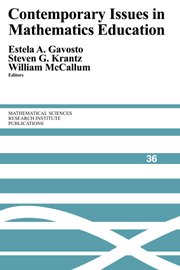Book contents
Redesigning the Calculus Sequence at a Research University
Published online by Cambridge University Press: 27 June 2025
Summary
The School of Mathematics at the University of Minnesota is developing a new calculus sequence for students in mathematics, science, and engineering. The sequence incorporates changes in content and methods of instruction. The students are routinely asked to work together cooperatively in small groups. An innovative feature involves student exploration of mathematical ideas and complex, open-ended, interdisciplinary applications using interactive features of the World Wide Web. This paper describes some of the special features of the sequence, including some different approaches to instructional teamwork and student-centered instruction. Student attitudes about the usefulness of the pedagogical and curricular components, and how these approaches affect their learning, are analyzed for this new sequence. Quantitative data are presented that compare the achievement and retention of students in the new sequence with a control group from the standard calculus sequence. Future directions for refinements in teaching the sequence, new curricular approaches, and additional statistical information are discussed.
Introduction
The major goal of the University of Minnesota Calculus Initiative is to create a challenging sequence for mathematics, science, and engineering students in which students obtain a better understanding of how to use calculus as a tool both for mathematical analysis and for solving problems in other disciplines. The new sequence is primarily intended for the middle 67% of the calculus-ready science and engineering students, and for some social science majors. The Initiative is a major reconceptualization of the traditional large lecture/recitation approach used in many doctoral institutions, and incorporates key aspects of successful calculus reform efforts in a new instructional format and supportive learning environment.
Information
- Type
- Chapter
- Information
- Contemporary Issues in Mathematics Education , pp. 57 - 66Publisher: Cambridge University PressPrint publication year: 1999
